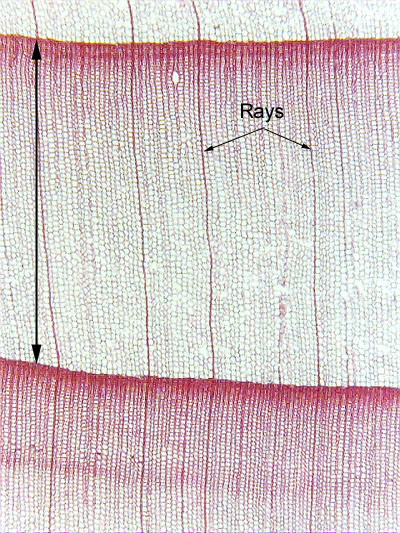 Fig.
15.1-2. Transverse section of wood of Thuja occidentalis
(American arbor-vitae, a conifer or softwood). The double-headed arrow indicates
a single thick annual ring. Rays are narrow and rather far apart, and the axial
system of the wood consists of just tracheids, with no fibers (that is why
conifers are called “softwoods”) and no vessels. The latewood tracheids make
up a relatively narrow band of darker red cells – they are dark because their
secondary walls are thick and therefore stain intensely. Earlywood tracheids
make up almost all the annual ring, and they have such thin secondary walls they
do not take up enough stain to be dark red.
Fig.
15.1-2. Transverse section of wood of Thuja occidentalis
(American arbor-vitae, a conifer or softwood). The double-headed arrow indicates
a single thick annual ring. Rays are narrow and rather far apart, and the axial
system of the wood consists of just tracheids, with no fibers (that is why
conifers are called “softwoods”) and no vessels. The latewood tracheids make
up a relatively narrow band of darker red cells – they are dark because their
secondary walls are thick and therefore stain intensely. Earlywood tracheids
make up almost all the annual ring, and they have such thin secondary walls they
do not take up enough stain to be dark red.
Many teaching labs for Plant Anatomy will use pine (Pinus) to illustrate conifer wood; that is shown in the next figure.